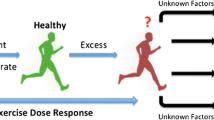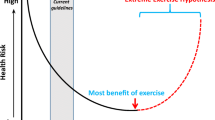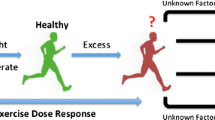Opinion statement
The benefits of regular and moderate exercise training on cardiovascular outcomes have been well established. In addition, strenuous exercise training leads to corollary cardiac structural and functional adaptations that are sport-specific and facilitate athletic performance. In this review, the normal physiologic and hemodynamic changes that occur during exercise and the subsequent differential exercise-induced cardiac remodeling patterns that develop will be discussed. Paradoxically, recent data have raised concern about the long-term impact of higher doses of physical activity and exercise on mortality and cardiovascular health outcomes. We will discuss important aspects of these controversial data and review the supporting evidence as well as the limitations of prior research. Specifically, we will address the association between high levels of exercise and relative reductions in overall mortality, increased risk of atrial fibrillation, arrhythmogenic cardiac remodeling, and accelerated coronary artery calcifications. For the practitioner, this review aims to detail these contemporary sports cardiology controversies and highlights the critical need to incorporate shared decision making with the athlete in dealing with the uncertainties that exist. Finally, we will discuss key “athlete-specific” variables that should be considered in the design of future important research in this arena.


Similar content being viewed by others
References and Recommended Reading
Papers of particular interest, published recently, have been highlighted as: • Of importance •• Of major importance
Paffenbarger RS Jr, Hyde RT, Wing AL, Lee IM, Jung DL, Kampert JB. The association of changes in physical-activity level and other lifestyle characteristics with mortality among men. N Engl J Med. 1993;328(8):538–45.
Sattelmair J, Pertman J, Ding EL, Kohl HW 3rd, Haskell W, Lee IM. Dose response between physical activity and risk of coronary heart disease: a meta-analysis. Circulation. 2011;124(7):789–95.
Sofi F, Capalbo A, Cesari F, Abbate R, Gensini GF. Physical activity during leisure time and primary prevention of coronary heart disease: an updated meta-analysis of cohort studies. Eur J Cardiovasc Prev Rehabil. 2008;15(3):247–57.
Wen CP, Wai JP, Tsai MK, Yang YC, Cheng TY, Lee MC, et al. Minimum amount of physical activity for reduced mortality and extended life expectancy: a prospective cohort study. Lancet. 2011;378(9798):1244–53.
Lee DC, Brellenthin AG, Thompson PD, Sui X, Lee IM, Lavie CJ. Running as a Key Lifestyle Medicine for Longevity. Prog Cardiovasc Dis. 2017;pii: S0033-0620(17)30048–8.
Baggish AL, Wood MJ. Athlete’s heart and cardiovascular care of the athlete: scientific and clinical update. Circulation. 2011;123(23):2723–35.
Pluim BM, Zwinderman AH, van der Laarse A, van der Wall EE. The athlete’s heart. A meta-analysis of cardiac structure and function. Circulation. 2000;101(3):336–44.
Baggish AL, Wang F, Weiner RB, Elinoff JM, Tournoux F, Boland A, et al. Training-specific changes in cardiac structure and function: a prospective and longitudinal assessment of competitive athletes. J Applied Physiol (1985). 2008;104(4):1121–8.
•• Andersen K, Farahmand B, Ahlbom A, Held C, Ljunghall S, Michaelsson K, et al. Risk of arrhythmias in 52 755 long-distance cross-country skiers: a cohort study. Eur Heart J. 2013;34(47):3624–31. This study is the largest cohort study of high-level endurance athletes demonstrating an association between endurance exercise and atrial fibrillation. Importantly, those athletes who competed in the most number of cross-country skiing events and who were the fastest were most at risk.
•• La Gerche A, Burns AT, Mooney DJ, Inder WJ, Taylor AJ, Bogaert J, et al. Exercise-induced right ventricular dysfunction and structural remodelling in endurance athletes. Eur Heart J. 2012;33(8):998–1006. In this study of 40 elite endurance athletes, an association was observed between reduced RV systolic function and increased cardiac biomarkers immediately after completion of an ultra-endurance exercise event. Additionally, a small number of athletes studied at baseline showed fibrosis in the right ventricle on cardiac MRI of unclear significance.
• Mohlenkamp S, Lehmann N, Breuckmann F, Brocker-Preuss M, Nassenstein K, Halle M, et al. Running: the risk of coronary events : prevalence and prognostic relevance of coronary atherosclerosis in marathon runners. Eur Heart J. 2008;29(15):1903–10. This study found increased coronary artery calcium scores in veteran marathon runners compared to relatively matched non-marathon running controls. Four marathon runners had coronary events within 2 years of follow-up.
Levine BD. Can intensive exercise harm the heart? The benefits of competitive endurance training for cardiovascular structure and function. Circulation. 2014;130(12):987–91.
O’Keefe JH, Lavie CJ. Run for your life ... at a comfortable speed and not too far. Heart. 2013;99(8):516–9.
Reynolds G. Can too much exercise harm the heart? New York Times. 2015. (http://well.blogs.nytimes.com/2015/12/30/can-too-much-exercise-harm-the-heart/?_r=0).
Rosenbaum L. Extreme exercise and the heart. The New Yorker. 2014. (http://www.newyorker.com/tech/elements/extreme-exercise-and-the-heart).
Rowell L. Human circulation: regulation during physical stress. New York: Oxford University Press; 1986.
Maron BJ, Zipes DP. Introduction: eligibility recommendations for competitive athletes with cardiovascular abnormalities-general considerations. J Am Coll Cardiol. 2005;45(8):1318–21.
Weiner RB, Wang F, Isaacs SK, Malhotra R, Berkstresser B, Kim JH, et al. Blood pressure and left ventricular hypertrophy during American-style football participation. Circulation. 2013;128(5):524–31.
Morganroth J, Maron BJ, Henry WL, Epstein SE. Comparative left ventricular dimensions in trained athletes. Ann Intern Med. 1975;82(4):521–4.
Lin J, Wang F, Weiner RB, DeLuca JR, Wasfy MM, Berkstresser B, et al. Blood pressure and LV remodeling among American-style football players. JACC Cardiovasc Imaging. 2016;9(12):1367–76.
Kim JH, Sher S, Wang F, Berkstresser B, Shoop JL, Galante A, et al. Impact of American-style football participation on vascular function. Am J Cardiol. 2015;115(2):262–7.
Arem H, Moore SC, Patel A, Hartge P, Berrington de Gonzalez A, Visvanathan K, et al. Leisure time physical activity and mortality: a detailed pooled analysis of the dose-response relationship. JAMA Intern Med. 2015;175(6):959–67.
Armstrong MEG, Green J, Reeves GK, Beral V, Cairns BJ. Response to letter regarding article, “Frequent physical activity may not reduce vascular disease risk as much as moderate activity: large prospective study of women in the United Kingdom”. Circulation. 2015;132(18):e225.
• Lee DC, Pate RR, Lavie CJ, Sui X, Church TS, Blair SN. Leisure-time running reduces all-cause and cardiovascular mortality risk. J Am Coll Cardiol. 2014;64(5):472–81. In this epidemiologic analysis, the authors found low-dose running significantly reduced all-cause and cardiovascular mortality. In addition, metrics of running dose were stratified into quintiles, and there were minimal differences in mortaliy benefit across quintiles.
Schnohr P, O'Keefe JH, Marott JL, Lange P, Jensen GB. Dose of jogging and long-term mortality: the Copenhagen City Heart Study. J Am Coll Cardiol. 2015;65(5):411–9.
Kim JH, Baggish AL. Physical activity, endurance exercise, and excess—can one overdose? Curr Treat Options Cardiovasc Med. 2016;18(11):68.
Chakravarty EF, Hubert HB, Lingala VB, Fries JF. Reduced disability and mortality among aging runners: a 21-year longitudinal study. Arch Intern Med. 2008;168(15):1638–46.
Clarke PM, Walter SJ, Hayen A, Mallon WJ, Heijmans J, Studdert DM. Survival of the fittest: retrospective cohort study of the longevity of Olympic medallists in the modern era. BMJ. 2012;345:e8308.
Farahmand BY, Ahlbom A, Ekblom O, Ekblom B, Hallmarker U, Aronson D, et al. Mortality amongst participants in Vasaloppet: a classical long-distance ski race in Sweden. J Intern Med. 2003;253(3):276–83.
Marijon E, Tafflet M, Antero-Jacquemin J, El Helou N, Berthelot G, Celermajer DS, et al. Mortality of French participants in the Tour de France (1947-2012). Eur Heart J. 2013;34(40):3145–50.
Sarna S, Sahi T, Koskenvuo M, Kaprio J. Increased life expectancy of world class male athletes. Med Sci Sports Exerc. 1993;25(2):237–44.
Iwasaki YK, Nishida K, Kato T, Nattel S. Atrial fibrillation pathophysiology: implications for management. Circulation. 2011;124(20):2264–74.
Elosua R, Arquer A, Mont L, Sambola A, Molina L, Garcia-Moran E, et al. Sport practice and the risk of lone atrial fibrillation: a case-control study. Int J Cardiol. 2006;108(3):332–7.
Heidbuchel H, Anne W, Willems R, Adriaenssens B, Van de Werf F, Ector H. Endurance sports is a risk factor for atrial fibrillation after ablation for atrial flutter. Int J Cardiol. 2006;107(1):67–72.
Karjalainen J, Kujala UM, Kaprio J, Sarna S, Viitasalo M. Lone atrial fibrillation in vigorously exercising middle aged men: case-control study. BMJ. 1998;316(7147):1784–5.
Molina L, Mont L, Marrugat J, Berruezo A, Brugada J, Bruguera J, et al. Long-term endurance sport practice increases the incidence of lone atrial fibrillation in men: a follow-up study. Europace. 2008;10(5):618–23.
Abdulla J, Nielsen JR. Is the risk of atrial fibrillation higher in athletes than in the general population? A systematic review and meta-analysis. Europace. 2009;11(9):1156–9.
Wilhelm M, Roten L, Tanner H, Wilhelm I, Schmid JP, Saner H. Atrial remodeling, autonomic tone, and lifetime training hours in nonelite athletes. Am J Cardiol. 2011;108(4):580–5.
Mozaffarian D, Furberg CD, Psaty BM, Siscovick D. Physical activity and incidence of atrial fibrillation in older adults: the cardiovascular health study. Circulation. 2008;118(8):800–7.
Scharf M, Brem MH, Wilhelm M, Schoepf UJ, Uder M, Lell MM. Cardiac magnetic resonance assessment of left and right ventricular morphologic and functional adaptations in professional soccer players. Am Heart J. 2010;159(5):911–8.
Marcus FI, McKenna WJ, Sherrill D, Basso C, Bauce B, Bluemke DA, et al. Diagnosis of arrhythmogenic right ventricular cardiomyopathy/dysplasia: proposed modification of the task force criteria. Circulation. 2010;121(13):1533–41.
James CA, Bhonsale A, Tichnell C, Murray B, Russell SD, Tandri H, et al. Exercise increases age-related penetrance and arrhythmic risk in arrhythmogenic right ventricular dysplasia/cardiomyopathy-associated desmosomal mutation carriers. J Am Coll Cardiol. 2013;62(14):1290–7.
Sharma S, Zaidi A. Exercise-induced arrhythmogenic right ventricular cardiomyopathy: fact or fallacy? Eur Heart J. 2012;33(8):938–40.
Benito B, Gay-Jordi G, Serrano-Mollar A, Guasch E, Shi Y, Tardif JC, et al. Cardiac arrhythmogenic remodeling in a rat model of long-term intensive exercise training. Circulation. 2011;123(1):13–22.
Ector J, Ganame J, van der Merwe N, Adriaenssens B, Pison L, Willems R, et al. Reduced right ventricular ejection fraction in endurance athletes presenting with ventricular arrhythmias: a quantitative angiographic assessment. Eur Heart J. 2007;28(3):345–53.
Douglas PS, O'Toole ML, Hiller WD, Hackney K, Reichek N. Cardiac fatigue after prolonged exercise. Circulation. 1987;76(6):1206–13.
Neilan TG, Januzzi JL, Lee-Lewandrowski E, Ton-Nu TT, Yoerger DM, Jassal DS, et al. Myocardial injury and ventricular dysfunction related to training levels among nonelite participants in the Boston marathon. Circulation. 2006;114(22):2325–33.
Scharhag J, George K, Shave R, Urhausen A, Kindermann W. Exercise-associated increases in cardiac biomarkers. Med Sci Sports Exerc. 2008;40(8):1408–15.
Whyte GP, George K, Sharma S, Lumley S, Gates P, Prasad K, et al. Cardiac fatigue following prolonged endurance exercise of differing distances. Med Sci Sports Exerc. 2000;32(6):1067–72.
Wilson M, O'Hanlon R, Prasad S, Deighan A, Macmillan P, Oxborough D, et al. Diverse patterns of myocardial fibrosis in lifelong, veteran endurance athletes. J Appl Physiol (1985). 2011;110(6):1622–6.
Bohm P, Schneider G, Linneweber L, Rentzsch A, Kramer N, Abdul-Khaliq H, et al. Right and left ventricular function and mass in male elite master athletes: a controlled contrast-enhanced cardiovascular magnetic resonance study. Circulation. 2016;133(20):1927–35.
Baggish AL, Yared K, Wang F, Weiner RB, Hutter AM Jr, Picard MH, et al. The impact of endurance exercise training on left ventricular systolic mechanics. Am J Physiol Heart Circ Physiol. 2008;295(3):H1109–h16.
Gaziano TA, Bitton A, Anand S, Abrahams-Gessel S, Murphy A. Growing epidemic of coronary heart disease in low- and middle-income countries. Curr Probl Cardiol. 2010;35(2):72–115.
Aikawa E, Nahrendorf M, Figueiredo JL, Swirski FK, Shtatland T, Kohler RH, et al. Osteogenesis associates with inflammation in early-stage atherosclerosis evaluated by molecular imaging in vivo. Circulation. 2007;116(24):2841–50.
Ross R. The pathogenesis of atherosclerosis: a perspective for the 1990s. Nature. 1993;362(6423):801–9.
Weber C, Noels H. Atherosclerosis: current pathogenesis and therapeutic options. Nat Med. 2011;17(11):1410–22.
Budoff MJ, Shaw LJ, Liu ST, Weinstein SR, Mosler TP, Tseng PH, et al. Long-term prognosis associated with coronary calcification: observations from a registry of 25,253 patients. J Am Coll Cardiol. 2007;49(18):1860–70.
Schwartz R, Schwartz JG, Wickstrom KK, Peichel G, Gerberich RF, et al. Increased coronary artery plaque volume among male marathon runners. Mo Med. 2014;111:85–94.
• Aengevaeren VL, Mosterd A, Braber TL, NHJ P, Doevendans PA, Grobbee DE, et al. The relationship between lifelong exercise volume and coronary atherosclerosis in athletes. Circulation. 2017;136:138–48. In this study, middle-aged runners with the highest lifetime exercise volume had higher CAC scores, prevalence of CAC, and plaque compared to runners with the lowest exercise exposure. Among those with plaque, participants in the most active group had less mixed plaque and were more likely to have only calcified plaques compared to the least active group.
•• Merghani A, Maestrini V, Rosmini S, Cox AT, Dhutia H, Bastiaenen R, et al. Prevalence of subclinical coronary artery disease in masters endurance athletes with a low atherosclerotic risk profile. Circulation. 2017;136:126–37. In this observational study, master athletes with low atherosclerotic risk had the same percentage of normal CAC as a healthy-matched control cohort. The master athlete cohorts were more likely, however, to have a CAC of > 300 compared to controls. Plaques found in master athletes were more likely to be calcific compared to those of controls.
Hagstrom E, Michaelsson K, Melhus H, Hansen T, Ahlstrom H, Johansson L, et al. Plasma-parathyroid hormone is associated with subclinical and clinical atherosclerotic disease in 2 community-based cohorts. Arterioscler Thromb Vasc Biol. 2014;34(7):1567–73.
Scott JP, Sale C, Greeves JP, Casey A, Dutton J, Fraser WD. The effect of training status on the metabolic response of bone to an acute bout of exhaustive treadmill running. J Clin Endocrinol Metab. 2010;95(8):3918–25.
Zerath E, Holy X, Douce P, Guezennec CY, Chatard JC. Effect of endurance training on postexercise parathyroid hormone levels in elderly men. Med Sci Sports Exerc. 1997;29(9):1139–45.
Criqui MH, Denenberg JO, Ix JH, McClelland RL, Wassel CL, Rifkin DE, et al. Calcium density of coronary artery plaque and risk of incident cardiovascular events. JAMA. 2014;311(3):271–8.
Kim JH, Malhotra R, Chiampas G, d'Hemecourt P, Troyanos C, Cianca J, et al. Cardiac arrest during long-distance running races. N Engl J Med. 2012;366(2):130–40.
Lamppa R. 2015 state of the sport—U.S. race trends. Running USA, 2015. (http://www.runningusa.org/annual-reports).
Baggish AL, Hale A, Weiner RB, Lewis GD, Systrom D, Wang F, et al. Dynamic regulation of circulating microRNA during acute exhaustive exercise and sustained aerobic exercise training. J Physiol. 2011;589(Pt 16):3983–94.
Baggish AL, Park J, Min PK, Isaacs S, Parker BA, Thompson PD, et al. Rapid upregulation and clearance of distinct circulating microRNAs after prolonged aerobic exercise. J Appl Physiol (1985). 2014;116(5):522–31.
Kim JH, Banton S, Awad M, Yadalam A, Sher S, Tran V, et al. Training-related metabolic adaptations in American-style football participants. Ann Sports Med Res. 2015;2(8):1048.
Lewis GD, Farrell L, Wood MJ, Martinovic M, Arany Z, Rowe GC, et al. Metabolic signatures of exercise in human plasma. Sci Transl Med. 2010;2(33):33ra7.
Acknowledgements
Dr. Kim is supported by the National Institutes of Health (K23 HL128795).
Author information
Authors and Affiliations
Corresponding author
Ethics declarations
Conflict of Interest
Patrick T. Gleason and Jonathan H. Kim each declare no potential conflicts of interest.
Human and Animal Rights and Informed Consent
This article does not contain any studies with human or animal subjects performed by any of the authors.
Additional information
This article is part of the Topical Collection on Sports Cardiology
Rights and permissions
About this article
Cite this article
Gleason, P.T., Kim, J.H. Exercise and Competitive Sport: Physiology, Adaptations, and Uncertain Long-Term Risks. Curr Treat Options Cardio Med 19, 79 (2017). https://doi.org/10.1007/s11936-017-0578-7
Published:
DOI: https://doi.org/10.1007/s11936-017-0578-7




